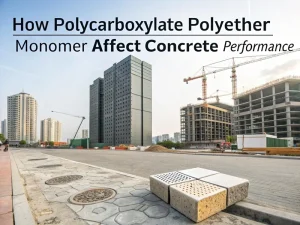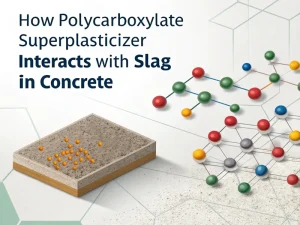Blog
Underwater concrete construction, from building bridge piers to offshore platforms, faces unique challenges. Traditional concrete mixtures are prone to erosion, segregation, and poor consolidation during underwater pouring. This is where underwater concrete admixtures play a crucial role. These specialized additives can enhance the performance of concrete, ensuring structural integrity and durability in underwater applications.
This article explores the types and functions of underwater concrete admixtures.
Without appropriate admixtures, concrete poured underwater faces three main problems:
Due to challenging environments such as water flow, static water pressure, and no mechanical vibration, underwater concrete differs significantly from onshore concrete. The ideal mixture must exhibit:
Admixtures address these challenges by altering the physical and chemical properties of concrete.
Superplasticizers, such as polycarboxylate superplasticizer (PCE), reduce water usage while maintaining processability. They disperse cement particles, prevent clumping, and improve fluidity. This enables concrete to self-compact underwater, thereby minimizing the need for vibration.
Advantage:
Reduce water-cement ratio and enhance strength and durability.
Realize high-performance underwater concrete with compressive strength exceeding 60 MPa.
VMA increases the viscosity of newly poured concrete, preventing segregation and erosion. They form a viscous matrix that can keep the aggregate suspended even in turbulent water. Common VMAs include hydroxypropyl methylcellulose (HPMC) and xanthan gum.
Advantage:
Maintain the uniformity of underwater concrete and ensure consistent strength. Reduce the risk of voids in concrete.
The retarder delays the setting time of concrete, providing more working time for underwater pouring. They are particularly useful in large-scale casting that requires continuous processability. Citric acid and sugar are common types of retarders.
Advantage:
Prevent premature solidification and allow seamless pouring of concrete in stages.
Reduce thermal cracks in large-volume concrete by controlling the heat of hydration.
AEA introduces tiny bubbles into the concrete matrix. In underwater applications, these bubbles act as flexible pads, reducing the impact of water pressure and freeze-thaw cycles.
Advantage:
Improving frost resistance is crucial for structures in cold aquatic environments.
Improve the workability and pumpability of underwater concrete.
Underwater concrete admixtures have completely transformed underwater construction, enabling it to build sturdy and durable structures in challenging aquatic environments. From superplasticizers that enhance fluidity to self-healing agents that have the potential to extend their lifespan, these additives are constantly evolving.
With the advancement of technology, the future of underwater construction lies in the development of more sustainable and high-performance additives. These will not only meet the growing demand for infrastructure projects, but also help establish a more resilient and eco-friendly built environment underwater.

How Polycarboxylate Polyether Monomer Affect Concrete Performance
Blog How Polycarboxylate

How Polycarboxylate Superplasticizer Interacts With Slag In Concrete
Blog How Polycarboxylate